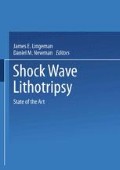Abstract
The Siemens Lithostar system consists of a motorized patient table, two integral electromagnetic shock wave generators, and biplane fluoroscopy for stone localization. Shock wave coupling is through water-filled bellows attached to the shock tubes. Seven of the first 30 patients (21%) required more than one treatment, even though the mean stone size was less than 13 mm. Seven other patients had poor fragmentation: all had 4 mm to 5 mm fragments. The mean number of shock waves delivered was 3,100.
The unit was realigned six weeks after the first patient was treated. Pulverization was excellent in the first 30 patients who were treated after this optimization procedure. Mean stone size was 10 mm, and the mean number of shock waves delivered was 2,700.
The Lithostar can effectively pulverize most upper urinary tract calculi. The modest shock wave pressures minimize the need for anesthesia but may hinder the treatment of impacted ureteral stones or difficult-to-fragment renal calculi.
The first extracorporeal shock wave lithotripter to use electromagnetic shock wave generation was developed by the Siemens Corporation at the Department of Urology of Mainz University under the direction of Prof. Rudolf Hohenfellner.1 Clinical trials were initiated in 1986 in West Germany. The first two Lithostars in the United States were installed at the Washington University School of Medicine in St. Louis and the University of Virginia School of Medicine in Charlottesville, Virginia. Clinical trials began at the University of Virginia on March 3, 1986.
Access this chapter
Tax calculation will be finalised at checkout
Purchases are for personal use only
Preview
Unable to display preview. Download preview PDF.
References
Wilbert DM, Reichenberger H, Noske E, et al: New generation shock wave lithotripsy. J Urol 138: 563, 1987.
Whelan JP and Finlayson B: Clinical application of blast path kinetics. Endourology 2: 13, 1987.
Korbon GA, Hurley DP, Williams GS: pH adjusted lidocaine does not “sting.” Anesthesiology 66: 855 (letter), 1987.
Johnson KS: Transcutaneous electrical nerve stimulation. In Raj PP (ed): Practical Management of Pain. Chicago: Year Book Medical Publishers, Inc., 1986.
Sackmann M, Delius M, Sauerbruch T et al: Shock wave lithotripsy of gallbladder stones. NEJM 318: 393, 1988.
Author information
Authors and Affiliations
Editor information
Editors and Affiliations
Rights and permissions
Copyright information
© 1988 Springer Science+Business Media New York
About this chapter
Cite this chapter
Jenkins, A.D. (1988). University of Virginia Lithostar Experience: Preliminary Report. In: Lingeman, J.E., Newman, D.M. (eds) Shock Wave Lithotripsy. Springer, Boston, MA. https://doi.org/10.1007/978-1-4757-1977-2_49
Download citation
DOI: https://doi.org/10.1007/978-1-4757-1977-2_49
Publisher Name: Springer, Boston, MA
Print ISBN: 978-1-4757-1979-6
Online ISBN: 978-1-4757-1977-2
eBook Packages: Springer Book Archive

